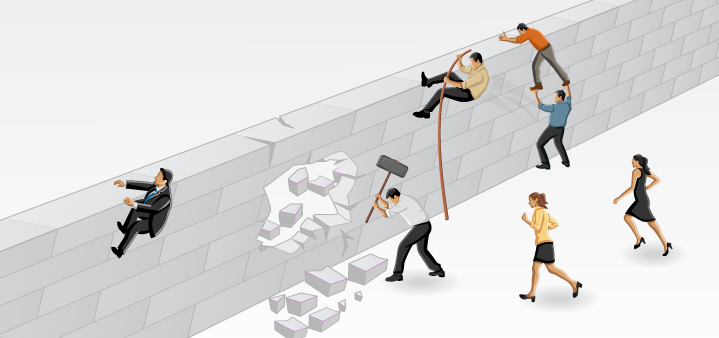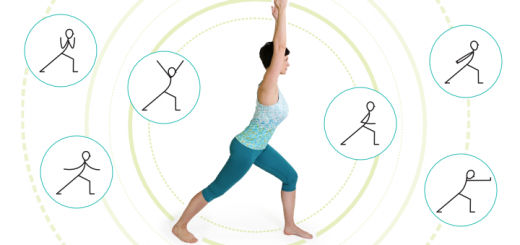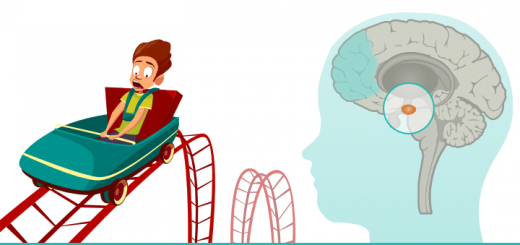How to overcome mental obstacles (part 1)
4According to Patanjali’s Yoga Sutras there are nine potential mental roadblocks that you can bump up against. When that happens, you might experience physical pain, anguish, agitation and disturbed breathing. Identifying an obstacle is useful for the purpose of “symbolic labeling”, which helps to release some of the emotional charge associated with it, and to set the course of action that would help overcome the obstacle. For example, you might discover that the distress that you are experiencing might be coming from reaching a plateau in your professional life. This realization can help you devise a plan for further advancement that might include continuing education courses, professional events, other teaching and learning opportunities. The types of steps you take in your life will depend on the kind of obstacle you encounter.
When it comes to your yoga practice though, Patanjali’s Yoga Sutras give one prescription that is expected to work for all obstacles. This prescription is “practicing one-pointedness” which means concentrating/meditating on a single principle for extended period of time. According to sutra 1.32 Consistently practicing one-pointedness keeps obstacles at a distance. Then Patanjali proceeds to give you a buffet of options for concentration that you can choose from.
1. Positive attitude toward others
The mind becomes purified by cultivating feelings of friendliness towards those who are happy, compassion for those who are suffering, goodwill towards those who are virtuous, and neutrality towards those we perceive as wicked or evil.
This is a challenging one to master. The tendency of the mind is always to compare our fortune to the fortune of others, and the mind likes to come up on top. So if somebody looks happy on his or her Facebook vacation pictures, we want to be happier, which becomes jealousy instead of friendliness. If somebody is having hard time in life the tendency is to find some fault of their own for the misfortune, because then it is less likely to happen to us, since we are making better choices. When somebody goes to faraway places to help clean up the mess after a hurricane, we might think of them as “pretend do-gooders who just want attention” because we ourselves are incapable of the same virtue. And, of course, when somebody is doing something we perceive as wrong or evil, we feel justified in being vocal and angry about it, which tends to escalate the conflict.
This sutra encourages us to examine our reflexive attitudes and make conscious choices about them. By consciously cultivating those recommended attitudes, we can practice yoga both on and off the mat and overcome our inner challenges. Some of those attitudes might come easier then others. The last part of this sutra (neutrality towards those we perceive as wicked or evil) seems to stir up the most discussion in the yoga circles because it appears as if it advocates inactivity in the face of injustice. It seems to discourage you from taking social action. It is particularly hard to come to terms with that in current divisive political climate.
I believe that it depends on your interpretation. I prefer to interpret it as “it is OK to act when you are faced with injustice, but do it from a place of neutrality and with clear head.” Then we end up “acting” instead of “reacting” which usually has a more positive impact.
2. Prolonged exhalation and suspension
The mind also attains serenity through prolonged Exhalation and Suspension of breath.
Every time you exhale you activate your parasympathetic system (“rest-and-digest mode”) slightly, which has a calming affect on the system. According to viniyoga tradition, holding the breath after exhalation (comfortably) amplifies that effect. When you hold the breath out you create a quiet space between the breaths, a place of refuge and possibility, where one breath is already over and another one has not begun yet. Sometimes we call that space “a doorway to serenity”. You can rest in that place of stillness; it helps clear your mind and find your inner peace.
3. Objective sensory perception.
Higher activity produced by objective sensory perception stabilizes and focuses thought.
Modern science confirms what yogis had discovered a long time ago: there are two distinctive and very different ways of experiencing the world. One involves “narrative brain circuitry”, when you mentally narrate a story about your past, future, all the people you know, how it all fits together – this is the “monkey mind”. “When you experience the world using this narrative network, you take in information from the outside world, process it through a filter of what everything means, and add your interpretations.”(1)
Another way of perceiving the world is called “direct experience” and it involves perceiving the world through your senses, without the additional filter of interpretations. You are taking in information in real time. “Activating the direct-experience network increases the richness of other incoming data, which helps you perceive more information around you. Noticing more information lets you see more options, which helps you make better choices.”(1)
When one way of perceiving the world becomes more active, another one becomes more subdued. As a result, if you get caught reminiscing, daydreaming or obsessing about something, you cannot experience the world through your senses fully (which can get you in trouble, if you miss a pothole in the pavement, for example). The reverse is true as well. When you focus on experiencing the world through your senses, you are less likely to worry, obsess and mull over the same thoughts over and over again. This is why the technique of “objective sensory perception” is being used widely by meditators of most traditions.
“Experiencing the world through the direct-experience network allows you to get closer to the reality of any event. You perceive more information about events occurring around you, as well as more accurate information about these events. Noticing more real-time information makes you more flexible in how you respond to the world. You also become less imprisoned by the past, your habits, expectations or assumptions, and more able to respond to events as they unfold.” (1)
Continue reading: How to overcome mental obstacles (part 2)
 Resources
Resources
-
Your Brain at Work: Strategies for Overcoming Distraction, Regaining Focus, and Working Smarter All Day Long by David Rock





















Thank you so much for this! It is very healing for me in my current situation.
You are very welcome, Rhett. I am thrilled to hear that you found it useful.
Wow, what a clear presentation you’ve laid out, and threaded directly back to the sutras too! I’ve just read this for the first time and there is so much here to explore! I actually copied this into my notes and intend to come back often to these ideas in my studies along my journey. So much gratitude for your dedicated work!
Thank you Jen! When I first started to study the sutras in depth, I was amazed at how many things I learned from other sources and was teaching came straight from the sutras. It’s so great to have this text as a potent resource – every time I re-read it I find something new and relevant. I am so happy to hear that you found my post useful!